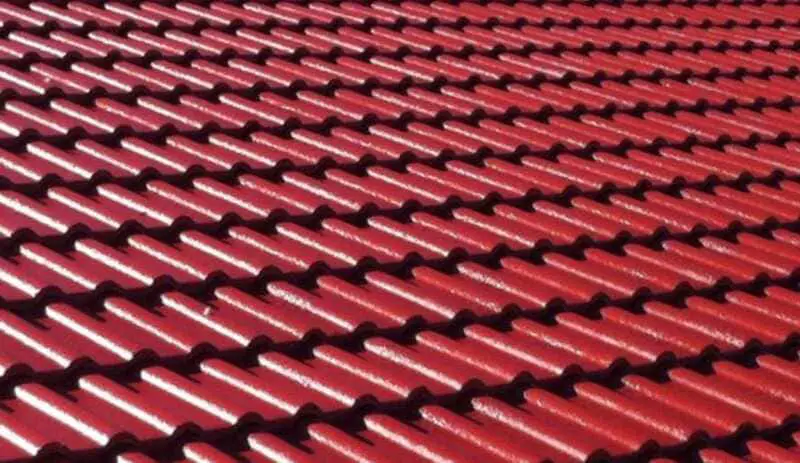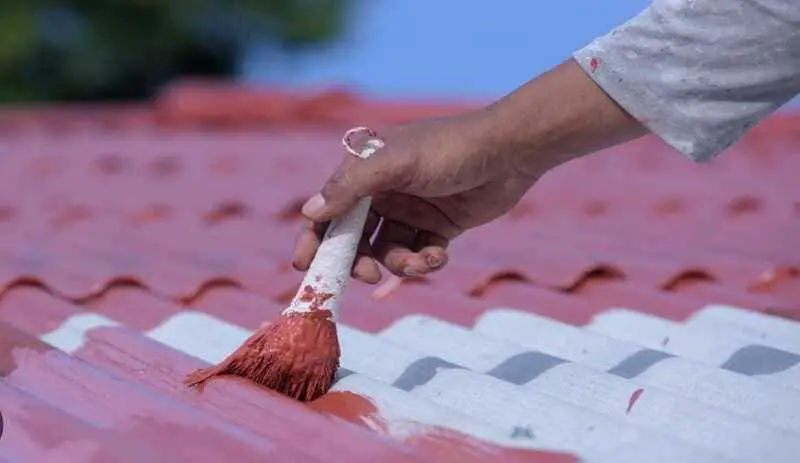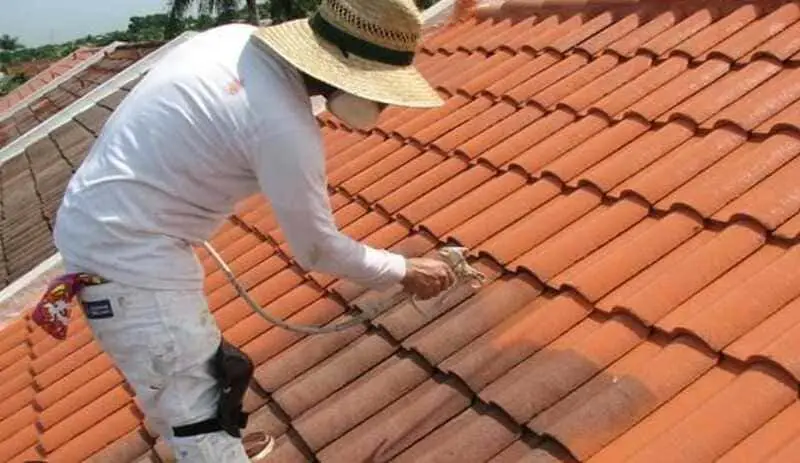Clay tiles are architectural elements of great beauty and durability, which have been used for centuries to protect our homes from the natural elements. However, with the passage of time and constant exposure to rain, sun and other climatic factors, these tiles can become porous and prone to water seepage. Waterproofing clay roof tiles then becomes an essential task to maintain their integrity and prolong their useful life.
In this article, we will explore in detail the necessary steps and techniques on how to waterproof clay tiles at home. We will provide you with valuable information on the different types of waterproofing available, as well as practical tips on how to properly prepare the tiles prior to application and ensure a long-lasting and effective finish.

Waterproofing not only protects clay tiles from water seepage, but also helps maintain the aesthetics and value of our home. In addition, by preventing moisture in the interior, it helps prevent mold problems and structural deterioration.
Importance of waterproofing to maintain the integrity of shingles.
Waterproofing plays a fundamental role in the maintenance and integrity of clay roof tiles in our homes. These tiles, known for their beauty and durability, are exposed daily to various climatic factors that can damage them over time.
One of the main challenges faced by clay tiles is water penetration. Rain, snow and general moisture can seep through porous tiles, creating an environment conducive to deterioration and the formation of mold and mildew. These problems not only compromise the aesthetics of our roof, but can also affect the structure of our home.
By waterproofing clay tiles, we create a protective barrier that prevents water from penetrating its surface. Water proofers, designed specifically for this purpose, seal the porosities of the tiles and form a water-resistant layer. This prevents leaks and keeps moisture from infiltrating into the interior spaces of our home.
In addition to protecting against moisture, waterproofing also helps preserve the appearance and value of our clay tiles. By forming a protective layer, discoloration caused by constant exposure to the sun is prevented and the risk of unsightly stains is minimized.

Another key benefit of waterproofing is its ability to prevent the growth of mold and mildew. Constant moisture on unprotected clay tiles can be an ideal breeding ground for these unwanted life forms. By sealing the tiles, we significantly reduce the favorable conditions for their proliferation, which in turn contributes to maintaining a healthier environment in our home.
Evaluation of the condition of clay tiles before waterproofing.
Before carrying out the process of how to waterproof clay tiles at home, it is crucial to perform a thorough evaluation of the condition of the tiles. This evaluation will allow us to determine if the tiles are in optimal condition to receive the waterproofing treatment and if any additional repair or preparation is necessary.
The first step in the assessment is to visually inspect the clay tiles for any signs of damage or deterioration. Look for broken tiles, cracks, peeling or any other irregularities that may compromise their integrity. It is important to remember that waterproofing will not fix structural problems, so address any damage before proceeding.
Also, pay attention to the accumulation of dirt, moss or algae on the shingles. These items can interfere with the adhesion of the waterproofing and affect its long-term effectiveness. If there is a significant buildup of dirt, the shingles will need to be thoroughly cleaned prior to application of the waterproofing product.
Once you have assessed the general condition of the clay tiles, it is important to check the roof drainage system. Make sure the gutters and drains are clean and functioning properly to prevent water accumulation on the roof. A poor drainage system can compromise the effectiveness of the waterproofing, as standing water can seep through the shingles and cause additional damage.
Types of waterproofing suitable for clay tiles.
When carrying out the process of how to waterproof clay tiles at home, it is essential to choose the right type of waterproofing that suits the specific characteristics and needs of this material. There are different options available in the market, each with its own advantages and applications.
One commonly used option is acrylic waterproofing. This type of coating forms a protective layer over clay tiles, sealing their porosities and providing excellent water resistance. Acrylic waterproofing is easy to apply, dries quickly and is often available in a variety of colors to match the architectural style of the home.
Another popular alternative is silicone waterproofing. This type of coating offers high water resistance and excellent durability. Silicone is a flexible material that adapts well to movement and dimensional changes that may occur in clay tiles due to climatic variations. In addition, silicone waterproofing is highly resistant to UV rays, which makes it ideal for protecting tiles from sun exposure.
Liquid rubber water proofers are also available. These products are applied as a liquid coating that dries to form an elastic membrane over clay tiles. Liquid rubber offers excellent waterproofing and flexibility, making it an effective option for protecting roof tiles from water seepage.
It is important to note that regardless of the type of waterproofing selected, it is necessary to follow the manufacturer’s instructions and make sure to properly prepare the tiles prior to application. This may involve cleaning the shingles, repairing cracks or crevices, and making sure the surface is dry and free of dirt before applying the waterproofing.
Proper preparation of the tiles before applying the waterproofing.
Before applying the waterproofing on clay tiles, it is essential to carry out a proper preparation to ensure optimum adhesion and long-lasting results. This preparation step is crucial to maximize the effectiveness of the waterproofing and ensure proper protection of the tiles.
The first step in preparation is to thoroughly clean the shingles. Removing any buildup of dirt, moss, algae or other debris is critical to ensure a clean, uniform surface. Dirt and contaminants can interfere with the adhesion of the waterproofing, so it is important to use proper cleaning methods, such as soft bristle brushes or gentle pressure washing.
In addition to cleaning, it is essential to repair any damage or irregularities in the shingles before applying the waterproofing. Carefully inspect the shingles for cracks, breaks or peeling and make any necessary repairs. Use appropriate repair materials, such as silicone caulk or mortar, to ensure that the shingles are in good condition prior to waterproofing application.
Another important aspect of preparation is to ensure that the shingles are completely dry before applying the waterproofing. Residual moisture on the shingles can interfere with the adhesion of the coating and compromise its effectiveness. If necessary, allow the shingles to air dry for an adequate period of time before proceeding with the application.
In addition, it is advisable to protect the surrounding areas of the shingles that are not to be waterproofed. Use masking tape or plastic to cover adjacent areas, such as gutters or decorative elements, and make sure they are well protected during the application process.
Methods of applying waterproofing on clay tiles.
There are different application methods that can be used for the task of how to waterproof clay tiles at home. The choice of method will depend on the type of waterproofing selected and individual preferences. Below, we will explore two common methods for applying waterproofing to clay tiles.
The first method is brushing. This technique involves applying the waterproofing directly to the tiles using a brush or paintbrush. It is important to use good quality tools and make sure to cover all areas of the tiles evenly. Brushing allows precise control over the amount and distribution of the waterproofing, which can be especially useful in hard-to-reach areas or on tiles with irregular textures.

Another common method is spraying. In this case, a sprayer or spray gun is used to apply the waterproofing to the tiles. This method is fast and efficient, as it allows large areas to be covered in a short time. However, it is important to keep in mind that skill and experience are required to achieve a uniform application and avoid the formation of excess or uncovered areas. In addition, appropriate protective equipment, such as goggles and masks, should be used to avoid inhalation of particles during the spraying process.

Regardless of the application method selected, it is essential to follow the waterproofing manufacturer’s instructions. This includes respecting drying times between coats and making sure to apply the recommended amount to achieve adequate protection.
It is important to remember that in some cases, it may be necessary to apply multiple coats of waterproofing to achieve optimum protection. This will depend on the type of waterproofing used and local climatic conditions. Pay attention to the manufacturer’s recommendations regarding the number of coats required and the time interval between coats.
Safety considerations when working with waterproofing.
When working with clay tile waterproofing products at home, it is important to keep safety considerations in mind to ensure a safe working environment and protect our health. These products contain chemicals and require proper handling precautions. Below, we will discuss some important considerations to keep in mind when waterproofing clay tiles.
First, it is critical to use personal protective equipment (PPE). This includes rubber gloves, safety goggles and face masks to protect our skin, eyes and respiratory tract from possible splashing or inhalation of vapors. Make sure PPE is in good condition and properly fitted before starting work.
In addition, it is essential to work in a well-ventilated area. Vapors released by waterproofers can be toxic if inhaled in high concentrations. Always perform the work outdoors or in spaces with good air circulation. If working indoors, be sure to open windows and doors, and use fans to promote ventilation.
Another important consideration is to avoid direct contact with the skin. Waterproofers can be irritating or corrosive to the skin. Always wear heavy-duty rubber gloves to protect your hands and be sure to wash them properly after application. In case of accidental skin contact, rinse the affected area with plenty of water and seek medical attention if necessary.
It is also crucial to follow the waterproofing manufacturer’s instructions. This includes respecting recommended drying times and application intervals. Avoid applying the product in adverse weather conditions, such as high winds or rain, which may interfere with the application process or affect the effectiveness of the waterproofing.
Finally, be sure to store waterproofing products safely, out of the reach of children and pets. Follow the manufacturer’s recommendations for proper storage, such as keeping them in a cool, dry place and avoiding exposure to high temperatures or sources of ignition.
Regular maintenance to prolong the life of waterproofed shingles.
Regular maintenance is critical to prolonging the life of waterproofed shingles and ensuring that they continue to adequately protect your home. Although waterproofing shingles provide a water-resistant barrier, it is important to perform some maintenance tasks to maintain their effectiveness over time.
One of the most important activities is to perform periodic inspections of the waterproofed shingles. Visually check the condition of the shingles and look for signs of wear, cracks, peeling or damaged areas. If you find any problems, it is important to address them immediately to avoid water leaks and additional damage. Make any necessary repairs using the appropriate materials according to the manufacturer’s instructions.
In addition to inspections, it is advisable to regularly clean the shingles to remove buildup of dirt, leaves, branches or other debris that can clog drains or damage the waterproofed surface. Use a soft brush or broom to clean the shingles carefully, avoiding the use of abrasive products that may damage the waterproofing coating.
Another important aspect of maintenance is the cleaning and unblocking of drainage systems, such as gutters and downspouts. Make sure they are free of obstructions to allow proper flow of rainwater. Water accumulations can put pressure on shingles and compromise the integrity of the waterproofing, so it is essential to keep drainage systems in good working order.
Also, be aware of the manufacturer’s recommendations as to the frequency and type of maintenance required for the specific waterproofing used on your clay tiles. Some products may require periodic reapplication to maintain their effectiveness over time.
Additional recommendations to protect clay tiles from external factors.
In addition to waterproofing clay tiles and performing regular maintenance, there are some additional recommendations that can help protect them from external factors and prolong their useful life. These additional precautions are especially important to ensure the durability of the tiles and maintain their aesthetic appearance. Here are some recommendations to keep in mind:
1- Protection against shocks and impacts: Earthenware tiles are susceptible to damage from hard knocks or impacts. Avoid walking or stepping directly on the tiles, as this can cause breakage or cracking. If you need to access the roof, use wooden planks or platforms to distribute the weight evenly and protect the tiles.
2- Tree pruning and maintenance: If you have trees near your roof, be sure to keep the branches trimmed and away from the shingles. Branches hanging over the roof can cause physical damage to the shingles, such as scratches or breaks. In addition, leaves and tree debris can accumulate on the roof and clog drains, which can negatively affect waterproofing and cause moisture problems.
3- Preventing moss and algae growth: Moss and algae can grow on clay tiles, especially in damp and shaded areas. To prevent their growth, make sure the roof receives sufficient sunlight and is well ventilated. If you notice signs of moss or algae growth, you can use specific products to gently remove them, following the manufacturer’s instructions.
4- Protection against birds and animals: Birds and other animals can cause damage to clay tiles. Avoid the accumulation of bird nests and droppings on the roof, as they can corrode the tiles over time. Use appropriate deterrents to prevent birds from nesting or roosting on the roof.
5- Avoid using harsh chemicals: When cleaning shingles or performing maintenance, avoid using harsh chemicals, such as strong acids or solvents. These products can damage the tiles and compromise their integrity. Opt for mild, non-abrasive solutions to safely clean shingles.
By following these additional recommendations, you will be able to protect your clay tiles from external factors and guarantee their resistance and beauty over time. Always remember to take precautions and follow the manufacturer’s instructions when performing any maintenance task on the roof. With proper care, you can enjoy protected and durable clay tiles in your home.

